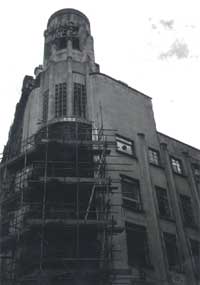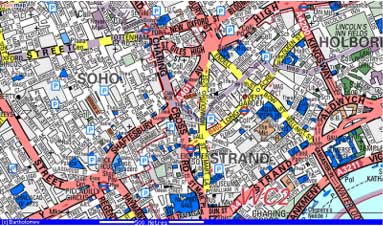|
|
 |
WALKING AND BIKE TOURS
Discover London walking or biking. We have short 1.5 hour tours and longer tours up to 4-5 hours covering more ground and more of London's history, iconic attractions and vibrant multicultural areas at the cutting-edge of cool.
Click here to review what's on offer. |
|
Exploring & Touring London
Another area of London to explore and experience. Click back to Touring London.
 |
| Exploring London's Art Deco Architecture |
Walking Art Deco London
by Andrew Reid (London, May 2003)
PART TWO:
 Start: Piccadilly Tube Station
Start: Piccadilly Tube Station
Finish: Fleet Street
Leave the station by the Lilllywhites exit and continue along, passed Virgin Record Store to Coventry Street where we come to the Prince of Wales Theatre (right). Originally the Prince Theatre built in 1884, Robert Cromie redesigned the theatre in 1937, with Gracie Fields laying the corner stone on the 17 of June of that year. Four months later the theatre staged its opening production, Les Follies de Paris et Londres. The building itself occupies a corner position and is rounded with a taut stone facade, topped by a round tower. It was just outside the Prince of Wales that a bizarre chain of events unfolded in March 1922. Following the brutal murder in Fulham of 25 year- old prostitute Gertrude Yates, working under the name of Olive Young, police gave chase to her suspected killer. Her killer, rather than cover his tracks, seemed to deliberately leave a trail, which eventually led to Coventry Street. After killing Olive Young with a wooden rolling pin, the tall, sleek, moustached 'Major' True greeted her cleaner and then hailed a taxi, which took him to Coventry Street. At this point he visited Horne's outfitters, buying a new hat and a suit, whilst still partly covered in blood. After asking for the blood covered trousers to be wrapped up he had a haircut and then pawned Olive Young's stolen jewelry. He then returned to Coventry Street and made his way to the entrance of the Prince of Wales Theatre where he was due to be picked up in a hired car with a driver. After his capture shortly after leaving this spot Major True was sentenced to death in May 1922 but was then sent to Broadmoor Hospital for the Criminally Insane. We now walk to the end of Coventry Street and enter Leicester Square where we can see the striking black shape of the Odeon.

Along with theatre, cinemas play an important role in Art Deco architecture as the mushrooming of the film industry coincides with the Art Deco period. Art Deco grandeur, opulence and international exoticism lends itself well to the image cinemas sought to project; an image of style, glamour, decadence. Many Deco cinemas have a vertical element. The Egyptian roots of Art Deco inspired many an obelisk. The towers acted as beacons of light, almost science fiction like. They also resemble the masts of ships. The Leicester Square Odeon, built in 1937 on the site of the Alhambra Theatre, is part of a 'house style' pioneered by Oscar Deutsch who championed a 'brand image' cinema. Harry Weedon and Cecil Clavering, along with George Coles, Andrew Mather and Robert Bullivant formed a group of designers who worked on the Odeon's house style. This style included the use of a finned tower, streamlined curves and baked clay tiles decorated with a glaze. Note the sharp lines. On the other side of the square is the Warner Cinema with its sweeping inward crescent, its huge black rimmed windows and glass roof house over one side, reminiscent of a the gun tower of a World War Two bomber. There are two friezes both of naked women. The Deco period saw the release of many films including Underground (1929) with Anthony Asquith, and set on the Northern Line, Dr Jekyll and Mr Hyde (1931), The Man Who Knew Too Much (1934) and a wealth of horror films such as Dracula (1931) and Frankenstein (1931). Hitchcock made his first major film, The Lodger in 1929 followed by The 39 Steps (1935). Many foreign films were set in London, which was seen as a glamorous location, for example the German film The Threepenny Opera (1931) by G W Pabst. Famous London born actors of the period include Boris Karloff and Charlie Chaplin, whose statue stands at the centre of the square. Judy Garland, star of the 1939 Art Deco classic The Wizard of Oz died in a public toilet in the square.
Leave Leicester Square through Leicester Place. This takes us to Lisle Street where we turn left. Here was the base of Eddie Manning. Manning was a Jamaican-born ponce who controlled prostitutes and drugs during the twenties, resulting in him being jailed in 1929. At the end of Lisle Street we get to Wardour Street. It was at 21 Wardour Street that Major True calmly had his hair cut after brutally bludgeoning Gertrude Yates/Olive Young on Monday 6th March 1922. True then popped into 27 Wardour Street to pawn two rings. From Wardour Street we turn right and then right again into Gerrard Street. It is here that the Chinese drugs baron Chan Nan ran the Palm Court. Here cocaine and heroin were used to get women dependent on drugs and thus dependent on the suppliers, who in turn forced the women into prostitution. Chan Nan was jailed in 1924. The Palm Court Club stands roughly opposite number 43 Gerard Street. The Chinese underworld of the Art Deco period is reflected in the 1929 film Piccadilly with Anna May Wong. Directed by DA Dupont, it involves seduction and intrigue. The British public's fascination with Chinese crime was further heightened by the murder of a Chinese honeymooning bride in the Lake District in 1929. The case made headline news and her newly wedded husband Chung Miao was convicted of her murder and hanged in Manchester in December 1929. Gerrard Street was also a popular haunt of streetwalkers and during the 1930s the Messina family controlled much of this trade. The Messinas arranged for women from mainland Europe to have marriages of convenience with poor English men. This move prevented them from being sent back home. Once in London the women were trapped into a life of prostitution centered on Mayfair, as well as Soho, where they were kept in flats.
From Gerrard Street turn into Dean Street and continue to Old Compton Street where we turn right. At 44 Old Compton Street pop into Patisserie Valerie which opened in 1926. The downstairs at least retains much atmosphere of a bygone age. From here we turn into Frith Street. It was here, in the same building as Cafe Italia that the first ever public transmission of TV took place in 1926, made by John Logie Baird. We return to Old Compton Street where we find the beautiful Art Deco Prince Edward Theatre. The Prince Edward opened in 1930. Its opening show Rio Rita, a Broadway spectacle, was a flop and by 1936 the theatre was in financial difficulty. It was relaunched as the London Casino and its Follies Parisienne was a success. We continue straight ahead till the end of Old Compton Street and turn left into Charing Cross Road where we stop to consider St Martin's School of Art and the Phoenix Theatre. From the Phoenix Theatre we turn south back down Charing Cross Road as far as Leicester Square Underground Station. There is an International style design to the Leicester Square Tube Station. Note the small row of windows above the doors on the left hand of the street. It is worth wandering briefly round the station. At this point it is interesting to consult one of the standard Tube maps. The distinctive circuit board design of the London Underground Map was designed during the Deco period. In 1931 Harry Beck was commissioned to design a new map for the system; he earned less than £5 for his effort! Incidentally, another map originates from the thirties; an unemployed woman called Phyllis Pearsall got so fed up trying to find streets and using bulky maps she simply designed her own set and put it in book form giving us the present A-Z.
Leave Leicester Square Station and turn into Long Acre, turning right into Garrick Street, home of the Garrick Club, the former of club of PG Wodehouse. Wodehouse was the creator not only of Bertie Wooster but also of the memorable characters of Ukridge in 1923 and Mr Mulliner in 1926. Members of the club wear salmon and cucumber ties. Could it be that Wodehouse got his inspiration for the notorious Drones Club from the Garrick? From Garrick Street make your way into Floral Street and continue to the end. This brings us to Bow Street Magistrates Court. It was here that Radclyffe Hall's novel The Well of Loneliness was declared obscene in 1928. The Well of Loneliness became a lesbian classic in later years. Radclyffe Hall was a close friend of Virginia Woolfe, another writer active during our period.
From the courts we continue south down Bow Street. Once past the Opera building turn right into Covent Garden. Here transport enthusiasts may enjoy the interior of a 1920s Metropolitan Line train at the London Transport Museum, along with many other exhibits from the Deco period. From the museum cross Tavistock Street and enter Exeter Street where we turn right. At the point where Exeter Street bends round towards the Strand, we can see a simple, white Art Deco building with a clock surrounded by green ceramic tiles. We continue a few steps into the Strand where stands the Strand Palace Hotel, designed by F. J Wells, designer of the Cumberland Hotel. The Strand Palace was built in its present form in 1929-30. Once a piece of Art Deco art, the lobby area, complete with luminous glass panels and designed by Oliver P.Bernard was gutted in 1969. Luckily the lobby was dismantled and removed to the V&A, where it remained in storage. It was reassembled as part of the 2003 V&A Art Deco Exhibition and has been described as one the finest examples of high-style Art Deco in Britain. In the Strand we head in the direction of Trafalgar Square to the west and pause to look at the gorgeous white tile clad Adelphi theatre. Note its taut, disciplined design and the diamond shaped window with black glass. Inside there are more Art Deco furnishings. Cross the road for a better view of the theatre. We should now turn the corner off the Strand and into John Adams Street where we can see the Adelphi building. The simple, thin bricked design is reminiscent of Dudok's work yet the over-the-top friezes, including elephants and fish, are more in the Art Deco style as is the imposing doorway. The names of various UK cities are marked around the building. Through the doors note the chandeliers and marble columns. Walk round the block into Adelphi terrace and look at the almost angelic statues facing out over the Thames. There is a definite Socialist Realist feeling to this structure. Retracing our steps to the Strand we now turn right and walk a few yards along where we find the Savoy. The Savoy is one of the most superb examples of Deco opulence in London. Whilst the building itself dates from 1889, it was expanded in 1920. Note the American Bar, the lobby and also the doorways. One can almost hear the ghost of Noel Coward playing here once again. Next door we can relish the Art Deco fittings of the Savoy Theatre.
Turn right into the Strand and continue as far as Lancaster Place, where you turn right and cross the Thames over Waterloo Bridge. As soon as you reach the south bank you will see some steps. Go down the steps here. This takes you to Riverside Walk. Continue past Gabriel Wharf as far as the OXO Tower. Previously a power station for the Post Office, then converted in the thirties into a meat packing plant by the Liebig Extract of Meat Company, the OXO tower was used as a way of circumventing a ban on advertising. The windows were so designed to spell out OXO, but as this is part of the design of the windows, the authorities could do nothing to prevent it. The tower was designed by Albert Moore. You can take a lift to the top of the tower for a spectacular view or enjoy a meal in the roof top restaurant. Back onto the path we continue east as far as Blackfriars Bridge.
We cross the bridge and pop into the weird Art Nouveau pub, the Blackfriars. We can stop here for a drink before passing Unilever House designed by Lomax Simpson with John Burnet in 1932. The sculptor of the statues was William Reid Dick. Note the lamps which flank the entrance, the motif which shows two birds on palms, the figures pouring grain into sacks, the figure climbing a palm, a Hercules-like figure confronting snakes and draped in a lion skin. There are many such details. The facade is built in Portland Stone with several bronze features. We continue up New Bridge Street until we reach Fleet Street where we turn left. The Daily Express Building was completed in 1932 by Sir E. Owen Williams with Ellis & Clarke. Note the glass and black, shiny Vitrolite exterior, using a curtain wall whereby the facade is hung on an internal frame. Note also the gold and chrome foyer with snake handrails, unusual lighting and paving, designed by Ronald Atkinson. Light is provided by steel stalactites. Its black design resulted in the nickname The Black Lubianka. Fittingly, the building was used in a dramatized version of Evelyn Waugh's 1938 novel Scoop. The building is sleek and curvy. Nearby we can see the Daily Telegraph Building at number 135, now occupied by a French bank. It was designed by Elcock and Sutcliffe in 1930 with a Greek and Egyptian feel. During the Deco period Fleet Street was buzzing with industrial activity, with modern printing works churning out thousands upon thousands of newssheets. We end our tour here. You can take a bus on the Strand, which will take you either to the Strand or to St Paul's.
|
|
|
|
